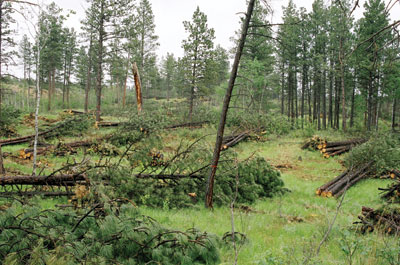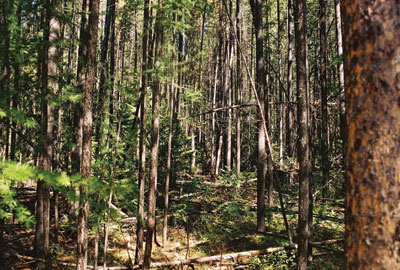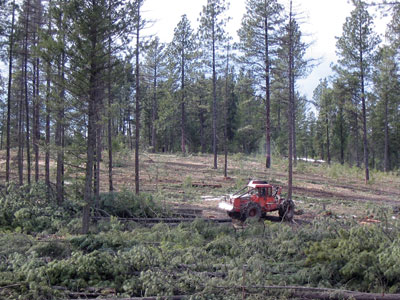
Freeing up Feedstock
April 1, 2011
By Robert Gray
Every summer a large number of communities face the threat of wildfires.
Every summer a large number of communities face the threat of wildfires. In British Columbia, the mountain pine beetle epidemic and climate change are further aggravating an already hazardous situation by creating additional hazardous woody fuels. Contributing in large part to the wildfire hazard are dense stands of small-diameter trees, dead lodgepole pine, and untreated timber harvesting slash. To date, governments’ solution to the fuel and wildfire threat issue has been to subsidize partially the on-site treatment or removal of the material. But, with the recession, there is no longer federal, provincial, or municipal funding for a subsidized approach to hazard abatement.
 |
|
| A designated wildland-urban interface area under the control of local government could be harvested for biomass, as well as sawlogs and pulpwood. Photos: Robert Gray
|
A more economically promising solution to the problem is the aggressive use of this biomass to produce energy. However, to make this solution a reality, the provincial government will need to move away from its passive approach to biomass feedstock availability and create opportunities for local governments to use the material through a re-apportionment of the resource. It will also need to encourage the use of the burgeoning biomass-to-energy industry to solve landscape-scale wildfire and forest health issues.
The wildfire hazard issue in British Columbia gained prominence after the 2003 wildfire season in which three fire fighters died, 350 homes and businesses were destroyed, 45,000 residents were evacuated, and the province spent more than $700 million in suppression and fire rehabilitation. The province commissioned former Manitoba premier Gary Filmon to review existing policy and procedures as they applied to wildfire threat to the wildland-urban interface (WUI) and to recommend changes so that what happened in 2003 wouldn’t be repeated. Two key recommendations from the Filmon Report relate directly to the biomass-to-energy industry: the need to add value to the small-diameter trees constituting the greatest threat to communities; and tenure reform, giving those who need to treat the material access to it.
First steps woefully inadequate
In response to the Filmon Report, the provincial government developed a grant program encouraging local governments to take the lead in resolving the wildfire threat to their communities. Developed through the Ministry of Forests and Range and administered by the Union of BC Municipalities (UBCM), the program comprised a partial grant (50% from the UBCM) to support the development of a Community Wildfire Protection Plan, as well as subsequent grants for fuel treatment pilot projects and operational fuel treatments (75% from UBCM if beetle-affected lodgepole pine was involved; otherwise 50%).
 |
|
| Forest licensees often will not treat hazardous stands near urban areas because of poor wood quality or quantity.
|
However, the Strategic Wildfire Prevention Program Initiative didn’t directly address the need to add value to forest fuels, as recommended; it only provided a partial subsidy for treatment. With treatments ranging in cost from $1,000/ha to more than $20,000/ha, the initial fund of $40 million didn’t result in much more than 40,000 ha treated out of an estimated 1.8 million ha that needed treatment. Some of the material was removed from treatment sites and used in the bioenergy industry, provided that a user was sited close to the operation. The rest was treated on-site through grinding, pile-and-burn, or broadcast burning.
On the tenure reform side, the province created several special licenses providing access to small quantities of biomass. This was initially a small-scale salvage licence for dead lodgepole pine, and eventually, an interface licence enabling a municipality to treat all species but in small volumes. New clean air legislation is also making small quantities of biomass available because the forest industry is no longer allowed to burn slash piles.
Unfortunately, none of these fixes deal with the necessity of providing sufficient access to predictable quantities of biomass feedstock so that an investor could be encouraged to build a bioenergy facility such as a thermal heating plant or wood pellet plant. With small treatment units of low-value material, there is little economic incentive for municipalities and businesses to pursue a bioenergy solution to the problem. So with federal and provincial fuel treatment grants drying up and local governments struggling to balance their budgets, movement on wildfire hazard reduction has come to a halt.
A new approach
An initiative that focuses on local governments directly managing the WUI around each of their communities is being championed by the southeastern British Columbia communities of Cranbrook, Kimberley, and St. Mary’s Indian Band, as well as the Ktuanxa Nation Council Society and the Rocky Mountain Trench Natural Resources Society. The proposed solution will not only add value to the material and provide access to feedstock, but will also reduce the need for fuel treatment subsidies in many cases. An economic and fire behaviour analysis would determine the appropriate width of the WUI buffer needed to develop biomass-to-energy industries capable of aggressively removing the fuel hazard from the forest. Within this WUI buffer would be sufficient biomass volume to develop both small-scale thermal heating projects as well as large-scale bioenergy products manufacture. The buffer would also contain large volumes of traditional sawtimber, which is more valuable on a volume basis than typical bioenergy material, but which is often needed to offset the harvest cost of biomass.
 |
|
| Mechanical thinning near forest communities can help reduce the risk of dangerous wildfires. |
This solution would require a change in the current tenure system, as the WUI buffer would need to be taken away from existing tenure holders and put under direct management by the municipality or First Nations Band. To date, the provincial government has been quick to declare that all the fibre in the province is under long-term tenure and there is none available to local governments for the development of biomass energy. Instead of creating new tenures, they are relying on a passive approach to biomass availability in the development of bioenergy industries. However, there are inconsistency and economical inefficiency issues with the government’s strategy.
Although much of the fibre in British Columbia is under long-term licence to the forest industry (and municipalities, in the case of Community Forest Licences), it is not true that it is unavailable to local governments for wildfire hazard reduction. Since the 2004 Filmon Report, the province has pressured local governments to take the lead in treating hazardous fuels on Crown land under long-term tenure to the forest industry (including BC Timber Sales). The province requests that local governments advocate the treatment of hazardous fuels on Crown land in the interface that is under licence to a long-term tenure holder. In many cases, the forest licensee will not treat the stand because of poor wood quality or quantity. If the licensee refuses to treat the stand, the local government is encouraged to use municipal tax dollars, in conjunction with provincial and federal grants, to treat the hazardous fuels. Under this strategy, the province thinks it’s appropriate for local governments to treat these stands but doesn’t afford them the opportunity to manage a large enough area or volume to make it economically efficient. And, from the perspective of avoiding a protracted battle over tenure reform, it is attractive to promote the development of bioenergy in a passive sense because it doesn’t require a reapportionment of resources or messy legislative changes. Under this model, biomass is only available as the opportunity arises.
The difficulty with this approach is that there is no predictability of feedstock availability, and the use of biomass is not tied to a larger economic goal or landscape management strategy. The small-scale licences and environmental legislation that free up small amounts of biomass are insufficient to stimulate bioenergy industries for two key reasons: the volumes are too small to support business planning and investment, and the volumes are not predictable from year to year. Opportunity biomass is tied directly to positive economic opportunities for sawtimber or pulpwood; if market conditions aren’t right for those commodities, the waste component that goes to bioenergy won’t be produced. In short, reliable biomass for energy can’t be a byproduct of harvest for other commodities.
Many benefits
However, the development of bioenergy opportunities also should not be the sole means to an end. It should be tied to meeting other social, environmental, or economic objectives such as WUI hazard reduction, as in the case of communities in southeastern British Columbia. Unlike other forms of bioenergy, failure to exploit the biomass resource comes with significant environmental, social, and economic consequences. If we don’t deal with the accumulated biomass proactively, we will have to deal with it during and after a wildfire at a significant cost to taxpayers, human health (e.g., smoke, direct threat to human lives), business, etc. It is therefore in the province’s interest to create and support the biomass-to-energy sector as a means of solving other problems. Direct government intervention in the timber supply and tenure arena is not without precedent. The government has amended tenures and licences in a number of locations over time to lessen the economic effects on a community or industry during periods of market instability (e.g., for the Skeena Cellulose pulp mill in Prince Rupert, the MacKenzie pulp mill, and others).
Currently there exists an unfortunate state of inertia as it relates to solving the WUI threat as well as the development of local, viable bioenergy enterprises. The interface fuels issue is quite simply a biomass issue: there is too much of it surrounding our communities and it constitutes a very real fire hazard. Ironically, the outstanding issue preventing the development of local-level, viable bioenergy enterprises is access to the biomass that creates this threat. The simplest solution is to amend the tenure system, allowing local governments and First Nations access to the biomass in strategic locations so they can address the wildfire hazard issue economically, encourage the development of local and viable bioenergy enterprises, and diversify the local energy and forest resource industries.
Robert W. Gray is a fire ecologist and principal of R.W. Gray Consulting Ltd., based in Chilliwack,
British Columbia.
Print this page